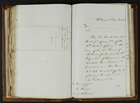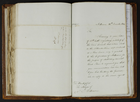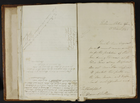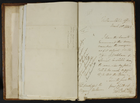Multimedia Content

Letter from Charles La Trobe to Mayor, 23 November 1844, courtesy of Public Record Office Victoria, Victorian Archives Centre.
Details
Letter from Charles La Trobe to Mayor, 28 December 1844, courtesy of Public Record Office Victoria, Victorian Archives Centre.
Details
Letter to Mayor from Police Magistrate, 13 March 1843, courtesy of Public Record Office Victoria, Victorian Archives Centre.
Details
Letter to Mayor from Police Magistrate, 10 March 1843, courtesy of Public Record Office Victoria, Victorian Archives Centre.
Details
Horseracing
By the time the British settlement of Melbourne was taking shape, horseracing was already a well-organised sport in New South Wales and Tasmania. The first sporting event in the town was a race meeting held in March 1838 on land west of Spencer Street. A committee of interested gentlemen prevailed on the Lieutenant-Governor for a grant of land for racing and in March 1840 a permanent racecourse, the Melbourne racecourse, was established at Flemington. The racing interest gradually assumed a formal structure, in 1842 forming the short-lived Port Phillip Turf Club and then the Victoria Turf Club in 1852. In 1856 the Victoria Jockey Club appeared but in 1864 the two amalgamated to form the Victoria Racing Club (VRC).
The wealth produced during the gold rushes made Melbourne the centre of Australian horseracing. By the 1850s the financial underpinnings of horseracing were sufficiently strong to support national competition and large purses were offered to attract good fields. In 1857 a challenge race between Melbourne's Alice Hawthorn and Sydney's Veno for the sum of 1000 sovereigns caused great excitement. Veno was shipped to Melbourne and won and, later the same day, raced against the Geelong horse Van Tromp, to win again. In 1859 the national agenda was further articulated when the Australian Champion Sweepstake was introduced with prize money of at least £500 to the owner. Similarly, the introduction of the Melbourne Cup in 1861 invited inter-colonial interest with the Sydney horse Archer winning the first two Cups.
The local popularity of horseracing saw racecourses established throughout the expanding metropolis. The Williamstown Racing Club, established in 1864, introduced the Williamstown Cup, the last of the four major races of the spring season. (Racing ceased at Williamstown in 1940.) The Victorian Amateur Turf Club, founded in 1876, established the Caulfield racecourse, and in 1879 the Caulfield Cup became the first major race of the spring season.
Private entrepreneurs also developed racecourses. Croxton Park in Northcote opened as a proprietary track in 1869, was not successful and closed in 1873. W.S. Cox, however, established a successful career based on his courses at Kensington Park (1874), Brighton Park and Elsternwick (1882) and the new and larger Moonee Valley in 1883. Other proprietary racecourses opened at Oakleigh Park (1888, renamed Sandown Park in 1892), Mordialloc, Mentone (1888), Epsom (1889), Maribyrnong and Aspendale (1891) and pony tracks at Thornbury (called Fitzroy), Oakleigh (1891) and Ascot (1893).
Horseracing was the main public forum for betting and gambling in the colony. Racing clubs raised prize money from the bookmakers, horse owners used the betting ring to support their pursuit and, as horseracing became more organised, betting on the horses became a popular pastime. Betting was legal but unregulated and horseracing became the target of all those who wished to change public behaviour by removing gambling from organised sport.
The battle-lines were drawn in the Parliament of Victoria. By the late 1870s the parimutuel or totalisator form of betting challenged the primacy of the bookmaker in offering a betting service to the public. John Wren, proprietor of the Collingwood Tote and pony tracks at Richmond, Fitzroy (Northcote) and Ascot, operated in competition with the VRC. But bills to introduce the totalisator in Victoria were defeated by the friends of the VRC and by the church-based anti-gambling lobby. In 1906 Wren's totalisator was closed, gambling was restricted to licensed on-course bookmakers, and the number of racing days allocated to proprietary racecourses reduced. Although the on-course totalisator was legalised in 1930, illegal off-course betting continued until 1960 when off-course betting through the Totalisator Agency Board (TAB) was legalised.
While race meetings were the only place for legal gambling, horseracing remained a very popular sport. By the late 19th century it was a major industry with paid racing club officials, trainers, jockeys and stable-hands. Under the Victoria Racing Club Act 1871, the VRC gradually exerted control over the sport through the registration of horses, the allocation of racing days and adopting and enforcing the Australian Rules of Racing in 1912. The government, too, was involved in the regulation of racing, closing Sandown Park, Fitzroy (Thornbury), Aspendale and Richmond racecourses in 1931.
In the 1920s horseracing in Melbourne was given a major boost by the introduction of radio. Race-callers became popular heroes as they brought the noise and drama of racing into suburban homes. It was in this context that horses like Spearfelt, Phar Lap and Peter Pan became household names. Race-callers also, inadvertently, offered a service to the illegal betting scene as the gambling public could now listen to the races as they were run. After World War II horseracing was consolidated, centralised on the racing clubs based at Caulfield, Flemington and Moonee Valley, and at Sandown where a new course was opened in 1965. The late 1940s saw record crowds. Going to the races remained a major Saturday afternoon activity, with the Spring Carnival the high point of the racing year across the nation.
When the first TAB betting shops opened in 1961 the face of horseracing changed. The televising of races in hotels and TABs transformed the spectator experience. From the 1980s the racing clubs began to reconstruct facilities at the courses and to offer spectators a more attractive environment. The Melbourne Cup had always attracted horses from New Zealand, but from 1993 the VRC actively sought English and Irish horses to give the Cup an international dimension. The televising of the event worldwide adds to the significance of the Melbourne Cup as Australia's premier race.
In December 2001 Racing Victoria assumed responsibility for thoroughbred racing in Victoria and introduced the Super Vobis scheme that rewards successful Victorian owners and breeders. The Melbourne racing scene is now integrated firmly into a national calendar and horses, trainers and jockeys follow the major events around the country. The opening of the Australian Racing Museum at Federation Square in 2004 is testament to the significant role thoroughbred racing plays in the economic and cultural life of the city.
- References
- Lemon, Andrew, The history of Australian thoroughbred racing, Classic Reproductions, Melbourne, 1987-90. Details
